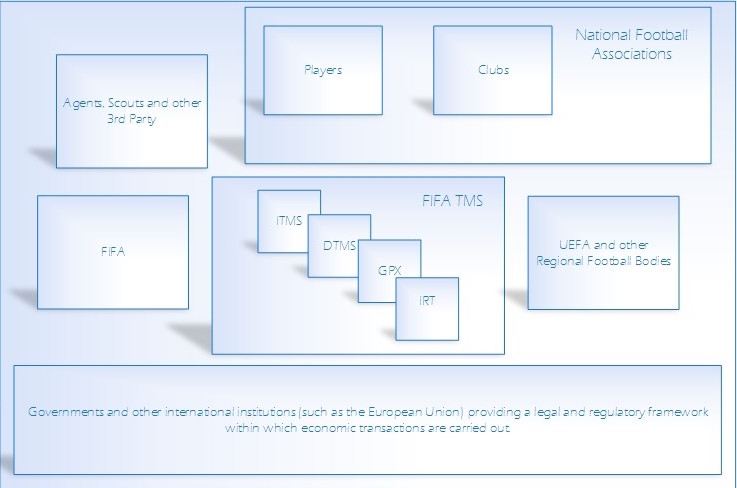Acknowledgement: This article has been adapted from a paper I submitted for a post-graduate course titled Managing Technological Innovation. During my research I had the privilege of interviewing Mark Goddard, former FIFA TMS General Manager. The paper was also reviewed by FIFA TMS management for information accuracy. I take this opportunity to thank you all for your support.
New Note 04.08.2017: FIFA TMS is no longer a subsidiary of FIFA and has since been reintegrated into FIFA as the TMS Global Transfers and Compliance department.
The FIFA1 Transfer Matching System (TMS) is an online platform for FIFA’s Member Associations and clubs to record international player transfers between clubs. In the FIFA Regulation on the Status and Transfer of Players (2012), it is described as a “web-based data information system with the primary objective of simplifying the process of international player transfers as well as improving the flow of information.” In professional football, a transfer is the action taken whenever a player moves from one football club to another.
The transfer of players is subject to various laws and regulations created by FIFA and regional governing bodies, namely, UEFA (Europe), the AFC (Asia), CAF (Africa), CONCACAF (North and Central America and the Caribbean), CONMEBOL (South America) and the OFC (Oceania). Below the regional confederations are individual national associations which, as well as being members of FIFA, are also members of their respective regional confederations. Football clubs are registered under their respective national associations. Together they form a global hierarchical structure with FIFA at the apex.
Due to the economic aspect of football, notably the transfer of players (labour), governments and inter-governmental bodies such as the European Union also have laws to regulate football in general.
Over the years, these laws and regulations have evolved to address a number of issues including transparency and accountability in player transfers, the free movement of players, protection of minors (Lembo, 2011), and Third Party Ownership and Intermediaries. The issue of Third Party Ownership and Intermediaries recently came to the fore with the resignation of England Manager, Sam Allardyce. You can read more on football’s Third Party Ownership rule here.
The TMS is a culmination of these efforts and demonstrates one of FIFA’s key innovation projects in the recent past. Schumpeter (1934) described innovation as any of the following phenomena: the introduction of a new good; the introduction of a new method (of production); the opening of a new market; the introduction of a new form of organisation. The FIFA TMS demonstrates all these characteristics – the system traces its origins to the creation of the FIFA Task Force dubbed For the Good of the Game, a new good.
Furthermore, the introduction of the TMS represented a new method as it replaced an old paper based system. TMS represented a revolutionary change in the technology used to manage the international transfer market. Before the introduction of the TMS in 2010, telephone, courier, fax and face-to-face meetings were the main components of the transfer management system. This resulted in delays, inaccurate information and numerous disputes on player contracts.
The introduction of the FIFA TMS also represents marketing as well as organisational innovation. FIFA, through its subsidiary FIFA TMS GmbH2 , opened up new markets by enabling FIFA to provide both free and premium services to FIFA member associations and their respective clubs. It is also worth noting that the TMS innovation project led to the establishment of the FIFA TMS GmbH a subsidiary company of FIFA providing various products and services related to the player transfer market. This is a demonstration of organisational innovation as well as technology transfer in practice. The next article will go deeper into technology transfer.

According to the FIFA TMS website, “Within 5 years, FIFA TMS was moved from being just a concept…to a fully-fledged company coordinating the international transfers of players across the world.” This article and the next takes a closer look at the FIFA TMS innovation project and the main approaches to innovation management.
The FIFA TMS Innovation Project
An innovation is the implementation of a new or significantly improved product (good or service), or process, a new marketing method, or a new organisational method in business practices, workplace organisation or external relations. The TMS perfectly fits this definition from the Oslo Manual: Guidelines for Collecting and Interpreting Innovation Data, 3rd Edition. We can also look at the TMS project using a simplified model of the innovation process, involving the following steps:
Search – the search for opportunity started with the formation of the Task Force, For the Good of the Game, which was convened to find solutions to financial problems involving corruption, ownership of more than one football club by a single individual or organisation, betting in football, money-laundering and the flow of money during player transfers, developments in the transfer market and players’ agent.
Select – in 2007 the Task Force submitted its report at the FIFA Congress proposing the formation of a “clearing house” for the international transfer of players, similar to what we have in the banking industry. This decision was ratified at the Congress and work on the TMS started. Among the first steps was the formation of FIFA TMS GmbH, to manage the TMS.
Implementation – The implementation of TMS took place from 2007 to October 2010 when transfer matching regulations were included in the FIFA transfer regulations making it mandatory for all international transfers to be entered in the transfer matching system. It is important to note that the International Transfer Matching System (ITMS) is provided as a free service to member associations and their clubs with training provided by FIFA TMS GmbH.
Capturing value – the conceptualisation of TMS led to the establishment of FIFA TMS GmbH, a spin-out company fully funded by FIFA but with the ultimate aim of becoming a self-funding enterprise. In January 2012 FIFA TMS got approval to develop self-funding projects, including premium content and services. These are actively marketed and sold to member associations. The next article on this blog will go further into this area as it dwells on technology transfer – the process through which innovators are able to create and capture value through the application of technology, knowledge and information.
The innovation can therefore be seen as taking the market or demand pull approach, where FIFA reacted to a growing need in the market and implemented a revolutionary system to address the same.
In summary, it is important to understand how the TMS is an innovation project, conceptualised in 2007 and delivered in 2010. It led to the establishment of a spin-out company which now manages not only the International Transfer Matching System (ITMS), but also related and integrated products and services such as the Domestic Transfer Matching System (DTMS), The Global Player Exchange (GPX) and the Intermediary Regulations Tool (IRT). FIFA TMS also provides free and premium data packaging services, made possible by the implementation and use of TMS.
The FIFA TMS technology was revolutionary in its application to the transfer market but the technology itself is quite generic. It is important to understand that the development of TMS will mainly constitute of products/services being added to the platform to provide services based on the transfer value chain. Outside of this, improvements to the technology will mainly be as a result of changes in the legal framework which should inform the TMS development.
An illustration of the FIFA TMS project and actors is presented below.

This high level system map illustrates the different actors involved with the FIFA TMS project. The key actor here outside of the TMS itself is FIFA, which provides funding to the TMS project. UEFA and other continental bodies would mainly play a support role for example by encouraging their member associations to adopt TMS products/services. They could also influence the development of the products through laws that they implement domestically within their own frameworks. National football associations and their member clubs are the main users and customers for FIFA TMS whereas agents, scouts and other 3rd parties (e.g. investors) could derive value from information services provided by TMS such as the GPX and data reports. All these actors work within a legal framework created by governments and intergovernmental organisations.
As earlier mentioned the next article will look into technology transfer, a key aspect of managing technological innovation.
References
Lembo, C., 2011. Fifa Transfers Regulations and UEFA Player Eligibility Rules: Major Changes in European Football and the Negative Effect on Minors. Emory Int’l L. Rev. 25, 539.
Schumpeter, J.A., 1934. The Theory of Economic Development: An Inquiry Into Profits, Capital, Credit, Interest, and the Business Cycle. Transaction Publishers.
[1] FIFA stands for Fédération Internationale de Football Association. It is the governing organisation of international football. It was created in 1904 under Swiss law to create an international structure for football.
[2] GmbH which is written after the name of the company, designates a company as private in German-speaking territory. The letters stand for Gesellschaft mit beschränkter Haftung. English equivalent is Limited (Liability Company), abbreviated as Ltd.





